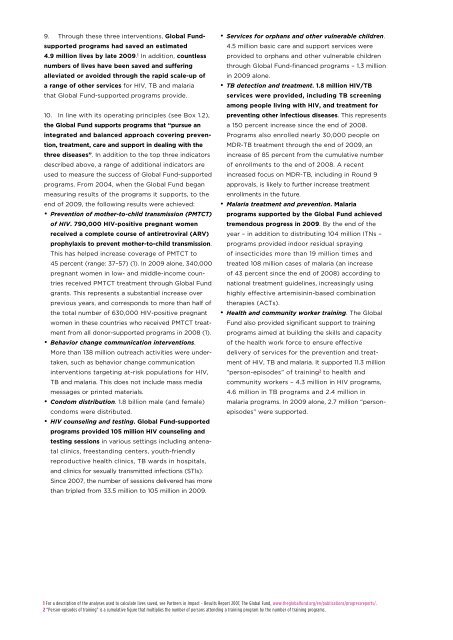Global Fund: Progress Report 2010 - unaids
Global Fund: Progress Report 2010 - unaids
Global Fund: Progress Report 2010 - unaids
You also want an ePaper? Increase the reach of your titles
YUMPU automatically turns print PDFs into web optimized ePapers that Google loves.
9. Through these three interventions, <strong>Global</strong> <strong>Fund</strong>supported<br />
programs had saved an estimated<br />
4.9 million lives by late 2009. 1 In addition, countless<br />
numbers of lives have been saved and suffering<br />
alleviated or avoided through the rapid scale-up of<br />
a range of other services for HIV, TB and malaria<br />
that <strong>Global</strong> <strong>Fund</strong>-supported programs provide.<br />
10. In line with its operating principles (see Box 1.2),<br />
the <strong>Global</strong> <strong>Fund</strong> supports programs that “pursue an<br />
integrated and balanced approach covering prevention,<br />
treatment, care and support in dealing with the<br />
three diseases”. In addition to the top three indicators<br />
described above, a range of additional indicators are<br />
used to measure the success of <strong>Global</strong> <strong>Fund</strong>-supported<br />
programs. From 2004, when the <strong>Global</strong> <strong>Fund</strong> began<br />
measuring results of the programs it supports, to the<br />
end of 2009, the following results were achieved:<br />
• Prevention of mother-to-child transmission (PMTCT)<br />
of HIV. 790,000 HIV-positive pregnant women<br />
received a complete course of antiretroviral (ARV)<br />
prophylaxis to prevent mother-to-child transmission.<br />
This has helped increase coverage of PMTCT to<br />
45 percent (range: 37–57) (1). In 2009 alone, 340,000<br />
pregnant women in low- and middle-income countries<br />
received PMTCT treatment through <strong>Global</strong> <strong>Fund</strong><br />
grants. This represents a substantial increase over<br />
previous years, and corresponds to more than half of<br />
the total number of 630,000 HIV-positive pregnant<br />
women in these countries who received PMTCT treatment<br />
from all donor-supported programs in 2008 (1).<br />
• Behavior change communication interventions.<br />
More than 138 million outreach activities were undertaken,<br />
such as behavior change communication<br />
interventions targeting at-risk populations for HIV,<br />
TB and malaria. This does not include mass media<br />
messages or printed materials.<br />
• Condom distribution. 1.8 billion male (and female)<br />
condoms were distributed.<br />
• HIV counseling and testing. <strong>Global</strong> <strong>Fund</strong>-supported<br />
programs provided 105 million HIV counseling and<br />
testing sessions in various settings including antenatal<br />
clinics, freestanding centers, youth-friendly<br />
reproductive health clinics, TB wards in hospitals,<br />
and clinics for sexually transmitted infections (STIs).<br />
Since 2007, the number of sessions delivered has more<br />
than tripled from 33.5 million to 105 million in 2009.<br />
• Services for orphans and other vulnerable children.<br />
4.5 million basic care and support services were<br />
provided to orphans and other vulnerable children<br />
through <strong>Global</strong> <strong>Fund</strong>-financed programs – 1.3 million<br />
in 2009 alone.<br />
• TB detection and treatment. 1.8 million HIV/TB<br />
services were provided, including TB screening<br />
among people living with HIV, and treatment for<br />
preventing other infectious diseases. This represents<br />
a 150 percent increase since the end of 2008.<br />
Programs also enrolled nearly 30,000 people on<br />
MDR-TB treatment through the end of 2009, an<br />
increase of 85 percent from the cumulative number<br />
of enrollments to the end of 2008. A recent<br />
increased focus on MDR-TB, including in Round 9<br />
approvals, is likely to further increase treatment<br />
enrollments in the future.<br />
• Malaria treatment and prevention. Malaria<br />
programs supported by the <strong>Global</strong> <strong>Fund</strong> achieved<br />
tremendous progress in 2009. By the end of the<br />
year – in addition to distributing 104 million ITNs –<br />
programs provided indoor residual spraying<br />
of insecticides more than 19 million times and<br />
treated 108 million cases of malaria (an increase<br />
of 43 percent since the end of 2008) according to<br />
national treatment guidelines, increasingly using<br />
highly effective artemisinin- based combination<br />
therapies (ACTs).<br />
• Health and community worker training. The <strong>Global</strong><br />
<strong>Fund</strong> also provided significant support to training<br />
programs aimed at building the skills and capacity<br />
of the health work force to ensure effective<br />
delivery of services for the prevention and treatment<br />
of HIV, TB and malaria. It supported 11.3 million<br />
“person-episodes” of training 2 to health and<br />
community workers – 4.3 million in HIV programs,<br />
4.6 million in TB programs and 2.4 million in<br />
malaria programs. In 2009 alone, 2.7 million “personepisodes”<br />
were supported.<br />
1 For a description of the analyses used to calculate lives saved, see Partners in Impact - Results <strong>Report</strong> 2007, The <strong>Global</strong> <strong>Fund</strong>, www.theglobalfund.org/en/publications/progressreports/.<br />
2 “Person-episodes of training” is a cumulative figure that multiplies the number of persons attending a training program by the number of training programs.

















